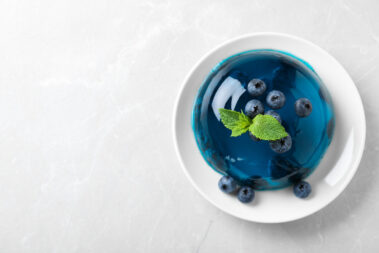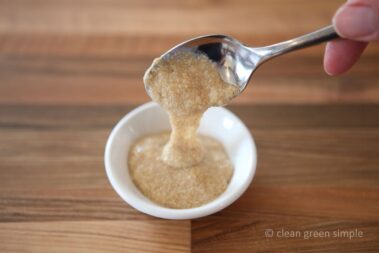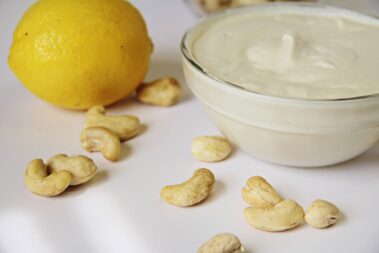To become a die-hard vegan, you have to give up not just meat, eggs, and dairy, but any product that requires an animal to create. This includes, of course, honey. If your search for an animal-friendly honey replacement has you wondering if you can substitute agave for honey, then you’ve come to the right place.
Yes, agave can be used as a honey substitute. The two products are similarly sweet and can be swapped at a one-to-one ratio in most recipes. But there are a few additional things you need to know before substituting agave for honey.
We’ll cover those extra baking points as well as your other agave-related inquiries, below.
Table of Contents
What Is Agave?
Agave syrup (or agave nectar) is extracted from the pina of the agave plant. The blue agave plant is most commonly used, but agave syrup can also be made from the salmiana agave plant.
These large succulents can grow up to six feet in height and have striking thick, spikey blue or green leaves. But it is the large underground pina that is most important for creating agave nectar.
This large round flower shoot can weigh up to 300 pounds and is full of sweet agave nectar. The pinas are roasted in large drums to break down the sap inside. They are then shredded and pressed, separating the liquid from the woody pulp.
Alternatively, the sap may be procured from the pina and then heated to remove the juice and concentrate the syrup.
Light Agave vs Dark Agave
Agave nectar is available in four varieties: light, raw, dark, and amber.
Light agave syrup isn’t heated as long, resulting in a highly sweet, thin syrup that has less flavor. This product is great for baking and using in recipes since it doesn’t affect the flavor of the final product.
Raw agave is a specialty type of light syrup that is never exposed to heat over 118 degrees. This ensures the enzymes inside remain intact. This variety has a similar mild flavor to other light types and is optimal for use in raw food creations.
Dark agave syrup is made from pinas that have been cooked for a longer period. Just as caramelizing sugar adds a complex flavor to the sweetness, cooking agave gives it depth and a distinct flavor. This stronger flavor is similar to molasses or golden syrup with a strong caramel flavor.
This variety works very well as a topping where extra flavor can help elevate the dish. Dark agave is also the preferred type for creating mezcal and tequila.
Somewhere between dark and light agave is amber agave syrup. This medium roast is cooked longer than light varieties but has a more subtle flavor and a lighter color than true dark agave. It’s a good compromise if you plan to use your agave to cook with and as a sweet topping.
Can Agave be Substituted for Honey?
Both agave and honey are sweeter than table sugar. Agave is about 50% sweeter, while honey is closer to 25%. This makes it easy to interchange these two sweeteners in recipes.
In fact, in most cases, you can simply substitute one cup of honey with one cup of agave without changing the overall profile of the dish. Light agave has the closest flavor profile to honey and is best used for creating cooked recipes and baked goods.
Agave also makes a great honey alternative for topping granola and yogurt, acai bowls, and oatmeal. It’s a bit runnier than honey, however, so making peanut butter and honey sandwiches using agave can get a bit messy.
But overall, honey and agave are similar enough that they can be substituted for one another without any changes to the other ingredients or recipe preparation.
Agave Substitution Breakdown
Agave is useful for more than substituting in recipes that call for honey. This all-natural sweetener can also be used in place of refined sugar, which is often processed using bone char and, thus, not safe for vegans.
Beyond animal-related products, agave syrup makes a suitable replacement for most sweeteners. But, because the sweetness level can differ between products, it’s key to use the right amount of agave. The table below shows exactly how much you’ll need to substitute the most common types of sugars and sweeteners.
| Sweetener Type | How Much Agave to Substitute |
| 1 cup honey | 1 cup agave |
| 1 cup white sugar | ⅔ cup agave (reduce liquid in recipe by 2 tbsp) |
| 1 cup brown sugar | ⅔ cup agave (reduce liquid in recipe by 2 tbsp) |
| 1 cup maple syrup | 1 cup agave |
| 1 cup brown rice syrup | ½ cup agave |
| 1 cup coconut sugar | ¼ cup agave (reduce liquid in recipe by 1 tbsp) |
| 1 cup coconut nectar | 1 cup agave |
| 1 cup golden syrup | 1 cup agave |
| 1 cup corn syrup | 1 cup agave |
| 1 cup rice malt syrup | ½ cup agave |
| 1 cup barley malt syrup | 1 cup agave |
When replacing granular sugars, such as refined sugar (white sugar), brown sugar, and coconut sugar, with agave, be sure to adjust the amount of water or milk in the recipe to account for the extra liquid. Similarly, if using less agave nectar than a not-so-sweet liquid like rice malt syrup or brown rice syrup, you may have to add a touch more milk or water.
Luckily, most common vegan sweeteners, including raw honey, maple syrup, and golden syrup, can be substituted at a one-to-one ratio.
The Benefits of Agave Nectar
Agave is a great sweetener to keep around the house since it can substitute for so many other sweet products. But its versatility isn’t the only reason you should consider using agave nectar.
This liquid sweetener comes with a lot of additional benefits in terms of nutrition, ease of use in baking, and ethics.
Nutritional
Nutritionally speaking, agave and honey have the same sugar content and the same calorie density.
Although, agave doesn’t have nearly as many phytochemicals (which act as antioxidants in the body) as honey. It also doesn’t have the same antiviral and antibacterial properties that honey does.
But what agave does have is a significantly lower glycemic index than honey.
The glycemic index (GI) of a food expresses how quickly it raises blood sugar when consumed. Frequent changes in blood sugar tax the body and may increase your risk for metabolic disorders like type 2 diabetes.
Of commonly used sweeteners, high fructose corn syrup has the highest GI at 87. Refined white sugar is close behind at 80. Honey is a respectable 50.
Agave, meanwhile, has a lower GI than even xylitol, coming in at 11. For people with diabetes and those looking to avoid blood sugar spikes, agave is a much better choice.
The low GI of agave comes from its high fructose content. Unlike glucose, which is processed by cells throughout the body, fructose is only processed in the liver. In terms of blood sugar levels, this is a good thing because it means they won’t spike.
But in terms of overall health, it means you need to take it easy on the agave. Eating too many simple, high-fructose foods can cause fatty liver issues and weight gain. Although, this second fact seems equally dependent on the amount of fat consumed along with that fructose(1).
For optimal health, all simple sweeteners should be consumed in restricted amounts and balanced with whole foods like fruits, veggies, and whole grains.
In Baking
In terms of baking or even savory meal prep, there are two places agave stands out.
For one, it’s sweeter than table sugar and a touch sweeter than honey. This means you need less of it to get the same amount of sweetness in the meal. And that means you’ll be consuming fewer calories.
Additionally, agave nectar is thinner than honey and dissolves much more easily in liquid. This is true whether the liquid is hot or cold.
Even compared to granulated sugar, agave mixes in much more quickly. This creates a more even distribution of sweetness through the batter, sauce, or latte you’re creating. And this means less stirring and whisking for you.
As a Vegan
And of course, for vegans, agave is a much better choice than honey.
While the natural production and passive harvesting of honey don’t inherently harm bees, the way the practice has evolved makes it much less humane than most people think.
In Nature, the queen bee is propagated through the selective feeding of royal jelly. In the industrialized honey complex, queen bees are forcefully bred in special labs. These lab queens are then placed into the hive in a special protective box after the hive’s original queen is culled by the beekeeper.
Many large-scale keepers take so much honey from their hives that the bees have nothing left to eat. To offset this, the honey is replaced with cheap sugar water. Generations of bees raised on nutrient-poor sugar has led to shortened lifespans and increased disease susceptibility, and is one of the factors implicated in colony collapse disorder (2).
Sometimes, even the cost of sugar water is too much for the industrialized honey industry to bear. When this is the case, large-scale beekeepers often cull entire colonies at the end of the summer rather than waste time and money feeding them sugar water over the winter.
No less so than the egg or dairy industry, the honey industry relies on inhumane practices and far-from-natural approaches to procure its product. For vegans who have chosen a plant-based diet due to animal welfare concerns, honey should absolutely be replaced by agave or other natural sweeteners in the pantry.
Get Sweet on Agave with These Recipes
Agave is an easy-to-use, low-glycemic, and humane option for satisfying your sweet tooth. This is true whether you’re adding some flavor to your acai bowl or mixing up a batch of brownies.
Here are some of our favorite recipes that incorporate agave as the sweetener of choice:
- Raw Vegan Brownies
- Carrot Ginger Dressing
- Chocolate Pots de Crème
- Oatmeal Pumpkin Bars
- Adzuki Vegan Chocolate Bites
- How to Pick the Perfect Watermelon For a Sweet Summer Treat - April 10, 2024
- Future Kind’s Foundations: A Multivitamin Made for Vegans - December 5, 2023
- Does Nutritional Yeast Go Bad? - November 28, 2023







